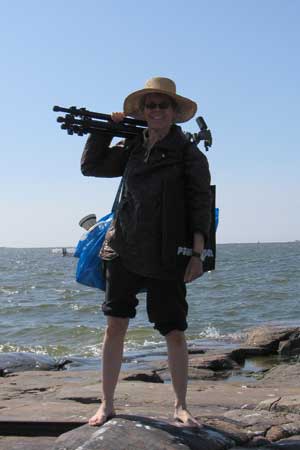Tuula Närhinen (b. 1967) is visual artist based in Helsinki, Finland.
"Images derived from scientific investigation are the core of Närhinen’s art, along with a dry sense of humor. She is an investigative artist, inventive and
methodical. Her works are installations that consist of series of photographs, drawings or sculptures. She has
built cameras that produce images of what she imagines the
world looks to a fly or a bear, developed methods for letting
trees trace the shape of wind on their branches, and found
techniques for using cold winter air to create patterns on
paper and glass. Homemade instruments and a documentation of the working method are important elements of her works. Her topics are landscape, natural phenomena and environmental issues." writes Paul Kahn in NEWmagazine.
She has a studio on the Harakka Island outside Helsinki. Most of her works have their origin in the island's nature.
Artist's statemant:
Närhinen’s work explores the physical and conceptual underpinnings of pictorial representation. She constructs experimental visual interfaces that connect the observer with the fabric of the world. Images that emerge from this interaction unravel the inherent pictorial potential in naturally occurring events.
Re-adapting methods and instruments derived from natural sciences, Närhinen facilitates the transcription of movements of different natural phenomena, such as water and wind into visual plots. The tracings and photographic recordings are created by the agency of nature itself– trees scribble and waves dash down their signatures. Närhinen constructs simple low-tech devices and uses various (photo)graphic techniques that enable us to move beyond the explicit and grasp the unfurling of a world invisible to the naked eye.
Her works result in spatial installations that, alongside the yielded (photo)graphs, artefacts and renderings, showcase the methods of inscription and the DIY instruments implicated. The poetics of her practice arise from the corporeal enactment and the exposition of the material process. She posits the gallery spectator as an embodied eyewitness to the spatial and medial translation of an event. The viewer of her works is encouraged to participate in the (re)presentation of the phenomena. A way of knowing and meaning making, generated by Närhinen’s experimental visual practice, provides for an artistic and critical approach to natural sciences and to the study of the phenomenal world.
